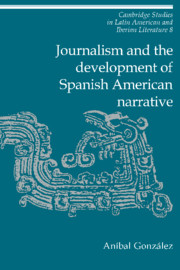Book contents
- Frontmatter
- Contents
- Acknowledgments
- 1 Journalism, modernity, and narrative fiction in Spanish America
- 2 Journalism and (dis)simulation in El Periquillo Sarniento
- 3 Sarmiento and sensationalist journalism: Facundo as crime story
- 4 Journalism versus genealogy: Ricardo Palma's Tradiciones peruanas
- 5 Journalism and the self: the Modernist chronicles
- 6 Journalism and the ethics of writing: Borges, García Márquez, Vargas Llosa, Poniatowska
- Notes
- Bibliography of works cited
- Index
5 - Journalism and the self: the Modernist chronicles
Published online by Cambridge University Press: 08 October 2009
- Frontmatter
- Contents
- Acknowledgments
- 1 Journalism, modernity, and narrative fiction in Spanish America
- 2 Journalism and (dis)simulation in El Periquillo Sarniento
- 3 Sarmiento and sensationalist journalism: Facundo as crime story
- 4 Journalism versus genealogy: Ricardo Palma's Tradiciones peruanas
- 5 Journalism and the self: the Modernist chronicles
- 6 Journalism and the ethics of writing: Borges, García Márquez, Vargas Llosa, Poniatowska
- Notes
- Bibliography of works cited
- Index
Summary
Marinetti's main idea is that everything is in what is to come and almost nothing in the past. In an ancient painting he only sees “the artist's painful contortions in his effort to break the insurmountable barriers to his desire to fully express his dream.” But have the moderns really achieved this? If we at least have to take one funeral bouquet every year to honor the “Gioconda,” what shall we do with the contemporary painters of golf courses and automobiles? So: Onwards! But, to where? If Time and Space no longer exist, isn't it the same to go Forwards as Backwards?
Rubén Darío, “Marinetti y el futurismo” (1911), in Obras completas, I, 616–23The Spanish American Modernists were a group of writers whose relationship with journalism, along with their desire to define literature, to seek out its “essence,” led them to a profoundly critical understanding of the nature of writing and of the literary craft. It is true that many other writers, in both Europe and North America, were also involved in journalism around the turn of the century, but what makes the Spanish American Modernists unique is the degree to which even the major figures in that movement, such as José Martí, Rubén Darío and José Enrique Rodó, depended on journalism not only to earn a living but also to publish their writings. The Modernists also exhibited an abiding concern with literary theory that, in my view, derived as much from their experience as journalists as from their acquaintance with philology. But before commenting on the Modernists' experience with journalism and its effect on their work, I will review the nature of Spanish American Modernism.
- Type
- Chapter
- Information
- Journalism and the Development of Spanish American Narrative , pp. 83 - 100Publisher: Cambridge University PressPrint publication year: 1993



